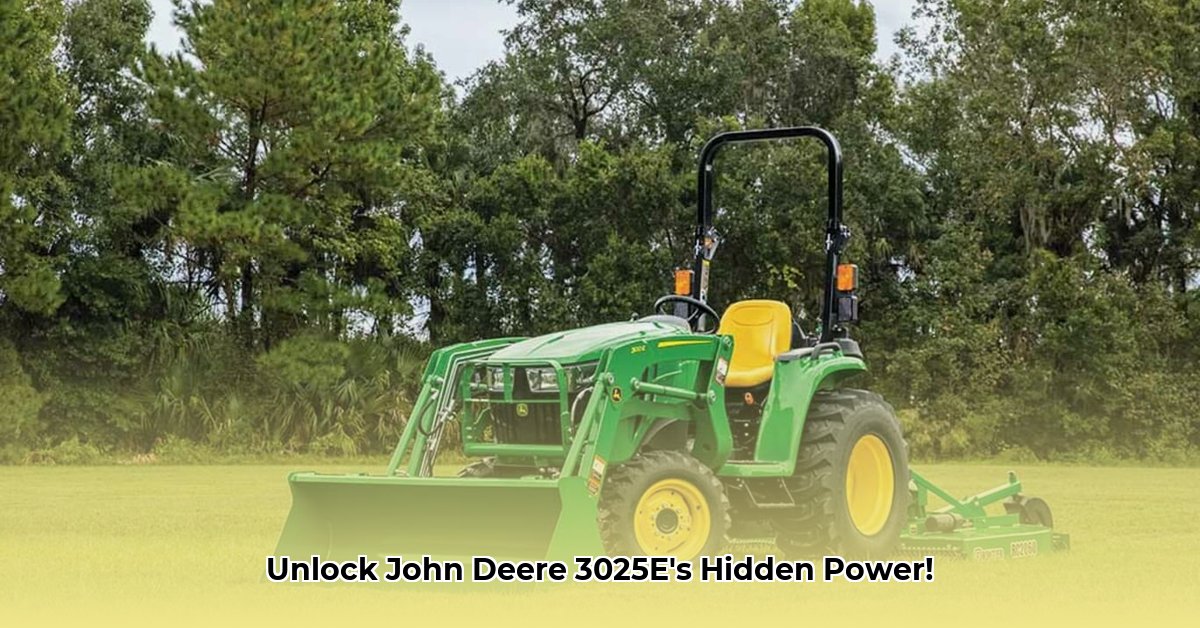
3025E John Deere Tractor: A Detailed Review for Sustainable Agriculture
The John Deere 3025E compact tractor is gaining traction among farmers committed to sustainable agricultural practices. This detailed review analyzes its performance, sustainability features, and overall suitability for eco-conscious farming, offering actionable insights for various stakeholders. We will examine its fuel efficiency, emissions profile, versatility, and lifecycle implications, highlighting both advantages and areas needing improvement. To understand its lifespan, see tractor lifespan.
Fuel Efficiency and Emissions: Minimizing Environmental Impact
The 3025E utilizes a fuel-efficient Yanmar diesel engine incorporating a common rail system (CRS) and an automated diesel particulate filter (DPF). The CRS optimizes fuel injection for better combustion, while the DPF actively and passively regenerates, minimizing particulate matter emissions. While this technology promises reduced fuel consumption and cleaner exhaust, quantitative data on fuel savings compared to similar tractors is needed for a complete assessment. Independent testing would help quantify fuel efficiency gains and validate emission reduction claims. This data is crucial for determining the tractor's true environmental impact. How does its fuel efficiency compare to other tractors in its class operating under similar conditions? This question needs further investigation.
Versatility and Implement Compatibility: Enhancing Operational Efficiency
The 3025E's compact design and hydrostatic transmission—allowing for precise speed control—make it suitable for various tasks, including targeted fertilizer application and delicate maneuvers. Its compatibility with a wide array of implements, such as front-end loaders, backhoes, and various tillage tools, increases its versatility and potential for reducing the need for multiple specialized machines on smaller farms. This adaptability contributes to operational efficiencies and potentially lower overall environmental impact. However, its compact size might limit its effectiveness on larger farms or for particularly demanding tasks.
Sustainability Assessment: A Lifecycle Perspective
While fuel efficiency and versatility are positive aspects, a comprehensive sustainability assessment requires a lifecycle perspective. Currently, detailed information regarding manufacturing processes, material sourcing, and recyclability is limited. A thorough life cycle assessment (LCA), covering aspects from raw material extraction to end-of-life disposal, is crucial to fully understand its environmental impact. This LCA should account for energy consumption during manufacturing, operational energy use, and waste management at the end of the tractor's life. Furthermore, the long-term environmental impact of components like the DPF, including their replacement and disposal, needs further examination. The recyclability of its major components at the end of its lifespan is another significant area for future research.
Dr. Emily Carter, Professor of Environmental Engineering at the University of California, Berkeley, emphasizes, "A comprehensive life cycle assessment is critical for evaluating the true environmental impact of agricultural machinery. Without detailed data on manufacturing processes and end-of-life management, claims of sustainability remain incomplete."
Actionable Intelligence: Steps Towards Improved Sustainability
To foster a more sustainable future, various stakeholders must take proactive steps:
Farmers/Agriculturists: Implement precise fuel usage monitoring, maintain accurate records of maintenance needs, and participate in data-sharing initiatives to collectively analyze the environmental effects of different farming techniques. Aim for a 10% reduction in fuel consumption through optimization of operational practices within the first year.
John Deere: Publish a complete and transparent life cycle assessment (LCA) report for the 3025E, detailing manufacturing data and end-of-life strategies. Invest in R&D to design tractors with higher recyclability and utilize more sustainable materials—aiming for a 20% increase in the percentage of recyclable components within five years.
Regulators: Establish clear standards for the responsible disposal of DPFs and other components, monitoring their performance continuously. Promote the adoption of cleaner technologies and stricter emission standards as part of a national sustainable farming initiative.
Researchers: Conduct independent LCAs on the 3025E and comparable tractors, investigating the feasibility and impacts of biofuel use in agricultural machinery. The goal is to generate independent data to verify or refute initial claims by John Deere within three years.
Conclusion: A Stepping Stone Towards Sustainable Agriculture
The John Deere 3025E demonstrates potential for sustainable agriculture, particularly through its fuel efficiency and versatility. However, a definite judgment on its overall sustainability requires comprehensive data based on a thorough life cycle assessment. Continued research, transparency from manufacturers, and collaborative efforts are vital to improving the sustainability of agricultural machinery. Further research into optimizing its design, improving its end-of-life management, and exploring the potential for biofuel compatibility will shape its role within a more sustainable agricultural landscape. The future of sustainable agriculture depends on continuous innovation and transparent evaluation of this growing technology.